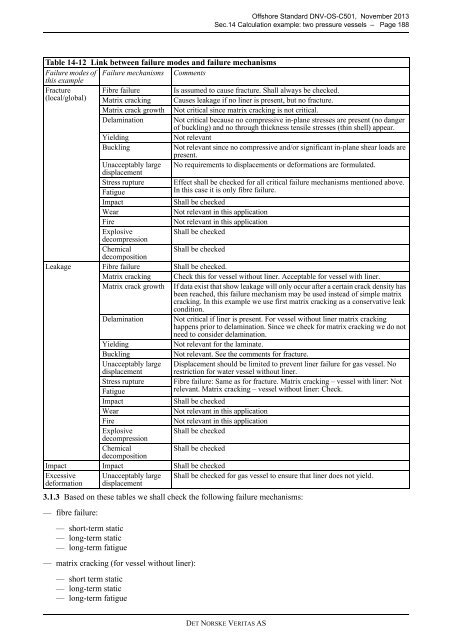OS-C501
Create successful ePaper yourself
Turn your PDF publications into a flip-book with our unique Google optimized e-Paper software.
Offshore Standard DNV-<strong>OS</strong>-<strong>C501</strong>, November 2013<br />
Sec.14 Calculation example: two pressure vessels – Page 188<br />
Table 14-12 Link between failure modes and failure mechanisms<br />
Failure modes of Failure mechanisms Comments<br />
this example<br />
Fracture Fibre failure Is assumed to cause fracture. Shall always be checked.<br />
(local/global) Matrix cracking Causes leakage if no liner is present, but no fracture.<br />
Matrix crack growth Not critical since matrix cracking is not critical.<br />
Delamination Not critical because no compressive in-plane stresses are present (no danger<br />
of buckling) and no through thickness tensile stresses (thin shell) appear.<br />
Yielding<br />
Not relevant<br />
Buckling<br />
Not relevant since no compressive and/or significant in-plane shear loads are<br />
present.<br />
Unacceptably large No requirements to displacements or deformations are formulated.<br />
displacement<br />
Stress rupture Effect shall be checked for all critical failure mechanisms mentioned above.<br />
Fatigue<br />
In this case it is only fibre failure.<br />
Impact<br />
Shall be checked<br />
Wear<br />
Not relevant in this application<br />
Fire<br />
Not relevant in this application<br />
Explosive<br />
decompression<br />
Shall be checked<br />
Chemical<br />
Shall be checked<br />
decomposition<br />
Leakage Fibre failure Shall be checked.<br />
Matrix cracking Check this for vessel without liner. Acceptable for vessel with liner.<br />
Matrix crack growth If data exist that show leakage will only occur after a certain crack density has<br />
been reached, this failure mechanism may be used instead of simple matrix<br />
cracking. In this example we use first matrix cracking as a conservative leak<br />
condition.<br />
Delamination Not critical if liner is present. For vessel without liner matrix cracking<br />
happens prior to delamination. Since we check for matrix cracking we do not<br />
need to consider delamination.<br />
Yielding<br />
Not relevant for the laminate.<br />
Buckling<br />
Not relevant. See the comments for fracture.<br />
Unacceptably large<br />
displacement<br />
Displacement should be limited to prevent liner failure for gas vessel. No<br />
restriction for water vessel without liner.<br />
Stress rupture Fibre failure: Same as for fracture. Matrix cracking – vessel with liner: Not<br />
Fatigue<br />
relevant. Matrix cracking – vessel without liner: Check.<br />
Impact<br />
Shall be checked<br />
Wear<br />
Not relevant in this application<br />
Fire<br />
Not relevant in this application<br />
Explosive<br />
decompression<br />
Shall be checked<br />
Chemical<br />
Shall be checked<br />
decomposition<br />
Impact Impact Shall be checked<br />
Excessive<br />
deformation<br />
Unacceptably large<br />
displacement<br />
Shall be checked for gas vessel to ensure that liner does not yield.<br />
3.1.3 Based on these tables we shall check the following failure mechanisms:<br />
— fibre failure:<br />
— short-term static<br />
— long-term static<br />
— long-term fatigue<br />
— matrix cracking (for vessel without liner):<br />
— short term static<br />
— long-term static<br />
— long-term fatigue<br />
DET NORSKE VERITAS AS



